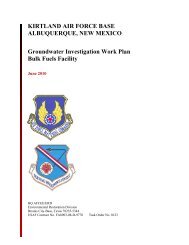Final FONSI and EA for hot cargo pad on Kirtland AFB - Kirtland Air ...
Final FONSI and EA for hot cargo pad on Kirtland AFB - Kirtland Air ...
Final FONSI and EA for hot cargo pad on Kirtland AFB - Kirtland Air ...
You also want an ePaper? Increase the reach of your titles
YUMPU automatically turns print PDFs into web optimized ePapers that Google loves.
<str<strong>on</strong>g>Final</str<strong>on</strong>g> <str<strong>on</strong>g>EA</str<strong>on</strong>g> Addressing C<strong>on</strong>structi<strong>on</strong>, Operati<strong>on</strong>, <str<strong>on</strong>g>and</str<strong>on</strong>g> Maintenance of a Hot Cargo Pad<br />
how far str<strong>on</strong>g shaking extends from the quake source. The hazard maps show the levels of horiz<strong>on</strong>tal<br />
shaking that have a 2 in 100 chance of being exceeded in a 50-year period. Shaking is expressed as a<br />
percentage of the <str<strong>on</strong>g>for</str<strong>on</strong>g>ce of gravity (percent g) <str<strong>on</strong>g>and</str<strong>on</strong>g> is proporti<strong>on</strong>al to the hazard faced by a particular type<br />
of building. In general, little or no damage is expected at values less than 10 percent g, moderate damage<br />
could occur at 10 to 20 percent g, <str<strong>on</strong>g>and</str<strong>on</strong>g> major damage could occur at values greater than 20 percent g. The<br />
regi<strong>on</strong> of Kirtl<str<strong>on</strong>g>and</str<strong>on</strong>g> <strong>AFB</strong> has a seismic hazard rating of approximately 16 to 20 percent g (USGS 2009).<br />
3.6 Water Resources<br />
3.6.1 Definiti<strong>on</strong> of the Resource<br />
Water resources include groundwater, surface water, <str<strong>on</strong>g>and</str<strong>on</strong>g> floodplains. Evaluati<strong>on</strong> of water resources<br />
examines the quantity <str<strong>on</strong>g>and</str<strong>on</strong>g> quality of the resource <str<strong>on</strong>g>and</str<strong>on</strong>g> its dem<str<strong>on</strong>g>and</str<strong>on</strong>g> <str<strong>on</strong>g>for</str<strong>on</strong>g> various purposes. Groundwater<br />
c<strong>on</strong>sists of subsurface hydrologic resources. It is an essential resource that functi<strong>on</strong>s to recharge surface<br />
water <str<strong>on</strong>g>and</str<strong>on</strong>g> is often used <str<strong>on</strong>g>for</str<strong>on</strong>g> potable water c<strong>on</strong>sumpti<strong>on</strong>, agricultural irrigati<strong>on</strong>, <str<strong>on</strong>g>and</str<strong>on</strong>g> industrial applicati<strong>on</strong>s.<br />
Groundwater typically can be described in terms of its depth from the surface, aquifer or well capacity,<br />
water quality, surrounding geologic compositi<strong>on</strong>, <str<strong>on</strong>g>and</str<strong>on</strong>g> recharge rate.<br />
Surface water resources generally c<strong>on</strong>sist of wetl<str<strong>on</strong>g>and</str<strong>on</strong>g>s, lakes, rivers, <str<strong>on</strong>g>and</str<strong>on</strong>g> streams. Surface water is<br />
important <str<strong>on</strong>g>for</str<strong>on</strong>g> its c<strong>on</strong>tributi<strong>on</strong>s to the ec<strong>on</strong>omic, ecological, recreati<strong>on</strong>al, <str<strong>on</strong>g>and</str<strong>on</strong>g> human health of a<br />
community or locale. The Clean Water Act (CWA) (33 U.S.C. 1251 et seq., as amended) establishes<br />
Federal limits, through the Nati<strong>on</strong>al Pollutant Discharge Eliminati<strong>on</strong> System (NPDES), <strong>on</strong> the amounts of<br />
specific pollutants that are discharged to surface waters in order to restore <str<strong>on</strong>g>and</str<strong>on</strong>g> maintain the chemical,<br />
physical, <str<strong>on</strong>g>and</str<strong>on</strong>g> biological integrity of the water. The NPDES program regulates the discharge of point (end<br />
of pipe) <str<strong>on</strong>g>and</str<strong>on</strong>g> n<strong>on</strong>point (storm water) sources of water polluti<strong>on</strong>. Secti<strong>on</strong> 404 of the CWA regulates the<br />
discharge of dredge or fill material into waters of the United States, which includes wetl<str<strong>on</strong>g>and</str<strong>on</strong>g>s. Waters of<br />
the United States are defined within the CWA, as amended, <str<strong>on</strong>g>and</str<strong>on</strong>g> jurisdicti<strong>on</strong> is addressed by the USEPA<br />
<str<strong>on</strong>g>and</str<strong>on</strong>g> the U.S. Army Corps of Engineers (USACE). See Secti<strong>on</strong> 3.7.1 <str<strong>on</strong>g>for</str<strong>on</strong>g> further details regarding<br />
jurisdicti<strong>on</strong> by these agencies <str<strong>on</strong>g>and</str<strong>on</strong>g> wetl<str<strong>on</strong>g>and</str<strong>on</strong>g>s, a subset of waters of the United States.<br />
Storm water is an important comp<strong>on</strong>ent of surface water systems because of its potential to introduce<br />
sediments <str<strong>on</strong>g>and</str<strong>on</strong>g> other c<strong>on</strong>taminants that could degrade surface waters. Proper management of storm water<br />
flows, which can be intensified by high proporti<strong>on</strong>s of impervious surfaces associated with buildings,<br />
roads, <str<strong>on</strong>g>and</str<strong>on</strong>g> parking lots, is important to the management of surface water quality <str<strong>on</strong>g>and</str<strong>on</strong>g> natural flow<br />
characteristics. Prol<strong>on</strong>ged increases in storm water volume <str<strong>on</strong>g>and</str<strong>on</strong>g> velocity associated with development <str<strong>on</strong>g>and</str<strong>on</strong>g><br />
increased impervious surfaces has potential to impact adjacent streams as a result of stream bank erosi<strong>on</strong><br />
<str<strong>on</strong>g>and</str<strong>on</strong>g> channel widening or down cutting associated with the adjustment of the stream to the change in flow<br />
characteristics. Storm water management systems are typically designed to c<strong>on</strong>tain runoff <strong>on</strong>site during<br />
c<strong>on</strong>structi<strong>on</strong> <str<strong>on</strong>g>and</str<strong>on</strong>g> to maintain predevelopment storm water flow characteristics following development,<br />
through either the applicati<strong>on</strong> of infiltrati<strong>on</strong> or retenti<strong>on</strong> practices. Failure to size storm water systems<br />
appropriately to hold or delay c<strong>on</strong>veyance of the largest predicted precipitati<strong>on</strong> event often leads to<br />
downstream flooding <str<strong>on</strong>g>and</str<strong>on</strong>g> the envir<strong>on</strong>mental <str<strong>on</strong>g>and</str<strong>on</strong>g> ec<strong>on</strong>omic damages associated with flooding.<br />
In 2010, the USEPA issued a <str<strong>on</strong>g>Final</str<strong>on</strong>g> Rule <str<strong>on</strong>g>for</str<strong>on</strong>g> the CWA c<strong>on</strong>cerning technology-based Effluent Limitati<strong>on</strong>s<br />
Guidelines <str<strong>on</strong>g>and</str<strong>on</strong>g> New Source Per<str<strong>on</strong>g>for</str<strong>on</strong>g>mance St<str<strong>on</strong>g>and</str<strong>on</strong>g>ards <str<strong>on</strong>g>for</str<strong>on</strong>g> the C<strong>on</strong>structi<strong>on</strong> <str<strong>on</strong>g>and</str<strong>on</strong>g> Development Point Source<br />
Category. All NPDES storm water permits issued by the USEPA or states must incorporate requirements<br />
established in the <str<strong>on</strong>g>Final</str<strong>on</strong>g> Rule. As of February 1, 2010, all new c<strong>on</strong>structi<strong>on</strong> (or demoliti<strong>on</strong>) sites that<br />
disturb <strong>on</strong>e or more acres of l<str<strong>on</strong>g>and</str<strong>on</strong>g> are required to meet the n<strong>on</strong>-numeric effluent limitati<strong>on</strong>s <str<strong>on</strong>g>and</str<strong>on</strong>g> effective<br />
erosi<strong>on</strong> <str<strong>on</strong>g>and</str<strong>on</strong>g> sedimentati<strong>on</strong> c<strong>on</strong>trols must be designed, installed, <str<strong>on</strong>g>and</str<strong>on</strong>g> maintained. These include:<br />
Kirtl<str<strong>on</strong>g>and</str<strong>on</strong>g> <strong>AFB</strong>, NM January 2011<br />
3-17
















